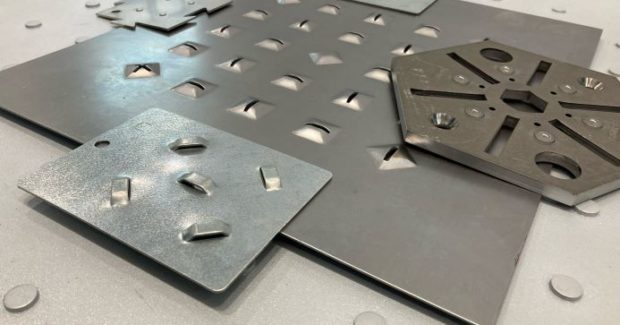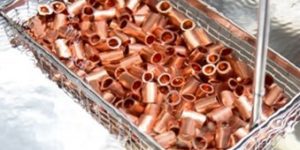Modern Punching Technology Makes Complex Sheet Metal Processing Easy and Attractive
The punch as a metal working tool offers overlooked advantages, including supporting and enhancing traceability in a sheet metal product.
Posted: July 19, 2021
THE CUTTING EDGE
By Tom Bailey
Looking around the fabrication industry in general and the trends in sheet processing techniques in recent years, it sometimes appears that punching is becoming less relevant as a technology, mostly because laser-cutting equipment becomes faster, more flexible, and more reliable each year.
It wasn’t that long ago that sheet metal parts with long, straight cuts (like those made all the time in the production of panels, trays and frames) or parts requiring a large number of holes were obvious candidates for punching. Now, the best solid-state lasers can often outrun a punching machine on the long straight cuts and on the perforating, without the need for any tool setup or maintenance.
Even though processing speed heavily favors the modern laser-cutting tool, the punch as a metal working tool brings a great deal of often-overlooked advantages. The most obvious advantage is the ability to form metal in addition to cutting out geometry. The classic image of the punch is the machine making countersinks, knockouts, and louvers all day long. Forming opens up many more possibilities than that though, and one of the most distinctive formed features on a sheet metal part is an emboss. Embossing might consist of a product name or a logo formed into the metal to create a 3-dimensional and tactile feature on the finished product. Embossing can also take other forms though. A common example is the tread pattern.
Formed tread patterns are typically added to deck plates and steps to create a safe stepping surface because smooth sheet metal does not provide much traction, especially if it gets wet or oily. Tread patterns can also give boxes and covers a more rugged appearance that might be desirable in the finished product. The traditional way to make these parts is buying sheet metal that is pre-formed with a tread pattern. This has the advantage of being quick and easy, but also has some limitations. Tread patterned sheets will have treads everywhere, in a uniform pattern, which means any parts cut out of those sheets will also have treads everywhere across the surface. Because the pattern is uniform across the sheet, it’s hard to control exactly where the treads will fall on the cut parts coming out of the sheet. The types of materials and thicknesses available from sheet suppliers also may not be ideal for the application at hand.
Forming tread patterns on a punch from regular sheet stock will occupy time on the machine but can have some interesting advantages. The type and thickness of material used is flexible. The pattern of treads can start and stop where desired on the part; the tread pattern can also be aligned to the part instead of being randomly determined by the nesting arrangement. Further, we can go beyond the traditional (and familiar) diamond-pattern treads and emboss a variety of different styles of treads, depending on the functional or aesthetic requirements of the product. More aggressive tread patterns can be used in demanding industrial applications: The steps of an oil-soaked catwalk should provide a positive grip for a work boot. On the other hand, treads that are used to create visual appeal can become more varied and unique, which often for the end customer winds up being the most important aspect of owning the product.
A NEW TWIST ON AN OLD TECHNOLOGY
Forming processes on a punching machine can also be used to support and enhance traceability in a sheet metal product. Embossing tools can be used to create alphanumeric strings that are completely indelible and will stand up through years of use, so that part numbers can be read easily throughout the life of the product. While embossing numbers is more visually appealing, dot-peening can also be used to flexibly create alphanumeric characters and any other shape you might need. Part numbers, alignment aids and service instructions can all be permanently marked on parts with a dot-peening process, and quickly changed as needed due to product revisions.
In a new twist on an old technology, dot-peening can also now be utilized to create 2-dimensional matrix codes. By mechanically adding a dot matrix code to a sheet metal component, important information can be encoded in a small area that can be easily read by anyone using a scanner (such as a smart phone with a camera). For example, the dot matrix might encode the link to a website that allows the product user to view and purchase spare parts just by holding their smart phone up to the code.
These are just a few examples of how mechanically formed features can make finished goods more useful and attractive for the end customer. In some cases, it can even mean the difference between a product that blends in with the competition and one that stands out. While the laser-cutting machine as a tool delivers unparalleled productivity, and high flexibility when it comes to making geometry, there are a whole range of sheet metal features that can only be added as a secondary process to a laser-cut part. On the other hand, machine tools that combine punching capability with laser versatility might just represent the ultimate thin sheet processing solution: The machine that really can do everything and deliver a fully featured and finished part right from the flat stock material.

















